Project history in Jitterbit Studio
Introduction
This page describes how to view a history of project events, create and manage snapshots, tag events and snapshots, and restore a project. The system stores project history for a maximum of 180 days. Snapshots remain available indefinitely. When you export a project, the system clears both the project history and snapshots from the exported version.
Access project history and snapshots
The Project history drawer is accessible from these locations:
-
The design canvas (see Design canvas actions menu in Design canvas).
-
The Projects page (see Tile view or List view in Projects page).
When you select Project History, a drawer opens on the right side of the project designer or Projects page. This drawer contains two tabs:
- Project history: Shows a list of project changes and deployments. Each entry includes the date, time, and the user who performed each action.
- Snapshots: Shows a list of snapshots that the system created automatically or that you created manually.
Both tabs support filtering, tagging, and project restoration.
View project history
The Project history tab shows project changes and deployments filtered by timeframe and event type. Project history updates appear in real time, including when a project is being simultaneously edited by multiple project collaborators.
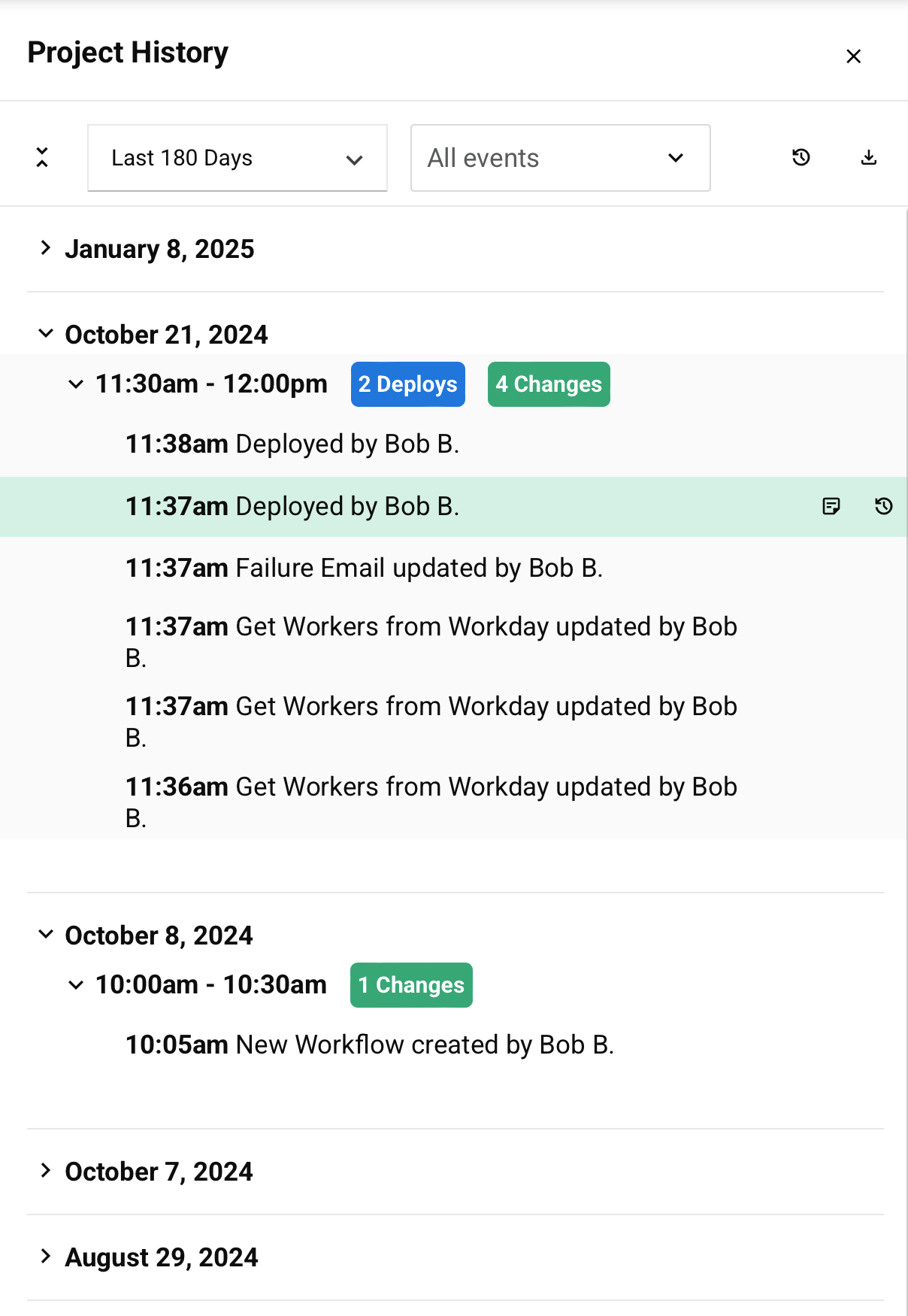
Search
Use the search box to enter a single keyword or keyword string. Only events containing the keyword string are shown, and the keyword string becomes highlighted in blue:

Filter by timeframe
Use the timeframe menu to select a period for displaying project history events.
The following options are available:
- Last 30 days
- Last 60 days
- Last 90 days
- Last 180 days
Note
Project history is stored for a maximum of 180 days.
Filter by event type
Use the event type menu to select which types of events to display.

The following options are available:
- All events: Displays all project history events. This includes change, remove, export, transfer, deploy, and restore events. Project history tags on these events are shown when present.
- Deploys: Displays deploy events.
- Migrations: Displays full project transfers.
- Imports: Displays import events.
- Transfers: Displays selective transfer events.
- Tagged: Displays transfer, deploy, and restore events that have been tagged.
Additional controls
The following additional controls are available:
-
Expand / Collapse all: Expands or collapses all the event details.
-
Restore last deployed version: Restores the project to the last deployed version. For information on restoring a project to a specific deploy, transfer, or restore event that occurred within the last 180 days, see Restore a project.
Note
Project restore events cannot be undone or redone.
-
Download as CSV: Downloads a CSV file that contains the current project history data based on the applied filters.
View events
Project history events are grouped by day and 30-minute intervals within each day in reverse chronological order, using the local browser time. Click the date or time row to expand or collapse events that are grouped together. A count of each deploy, change, remove, transfer, or import event is displayed below each 30-minute period.
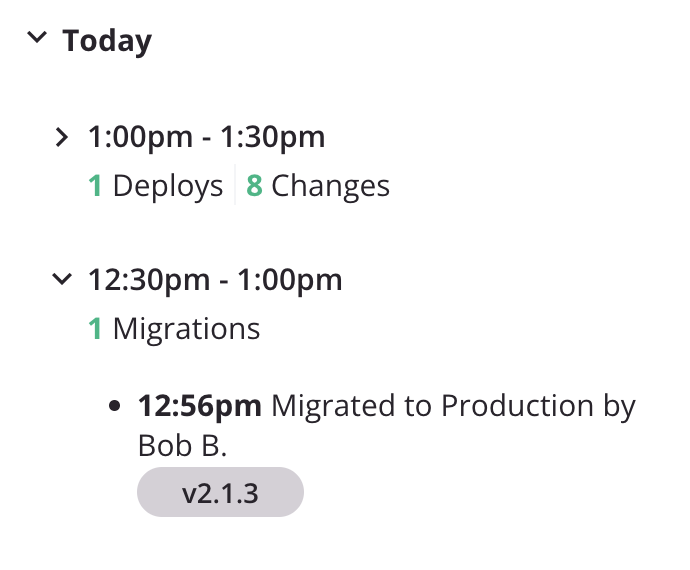
Each project history event is listed with a timestamp of the event and shows the first name and last name initial of the user who performed the action.
The following event types are available:
-
Change: The name of the component at the time it was created, updated, or deleted.

When accessing project history from within a project, the design canvas focuses to the selected component (if applicable) and outlines it with a blue border. The project pane's Workflows tab is displayed with a green background, and the component is selected in the project pane's Components tab.
-
Remove: The name of the component that was removed, followed by the name of the operation on the design canvas that the component was removed from.

When selected, the removed component is selected in the project pane's Components tab.
-
Export: The name of the project at the time it was exported.

-
Import: The component type and the name of the component at the time of import. A Replace icon indicates that the imported component replaces an existing component. A New icon indicates that the imported component is new.
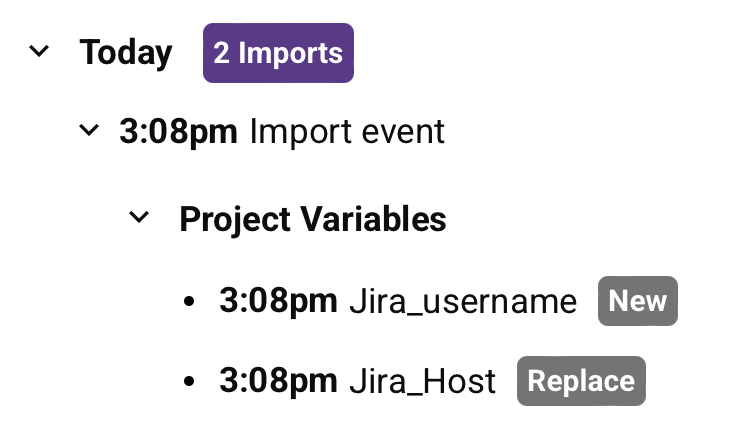
-
Transfer: A selective transfer event, along with the event's project history tag, if present.

-
Migrate: The name of the environment the project was transferred to or from, along with the event's required project history tag. Migration events are taggable and restorable.

-
Deploy: A deploy event, along with the event's project history tag, if present. Deploy events are taggable and restorable.

-
Restore: The name of the project at the time it was restored, along with the event's project history tag, if present. Restore events are taggable and restorable.

View and manage snapshots
The Snapshots tab shows a list of snapshots that capture the state of your project at specific points in time. Snapshots are created automatically with each deployment and can also be created manually:
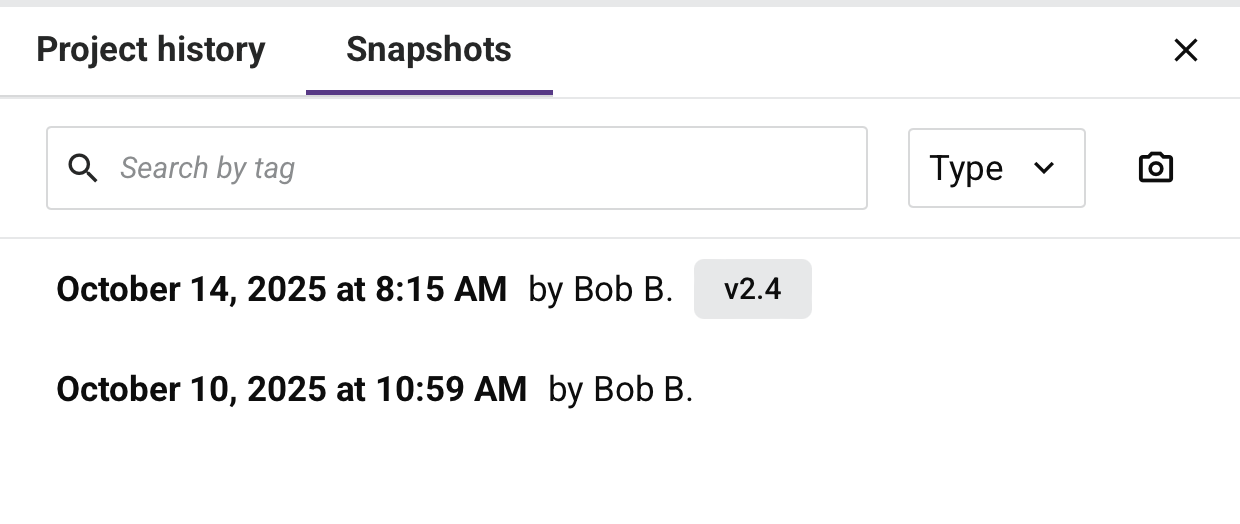
-
Search by tag: Use the search field to find snapshots by their tag names.
-
Type: Use the menu to filter snapshots by their type.
-
Automatic: Automatic snapshots captured during these events:
- Deployment: The project designer at the time of deployment.
- Transfer or migration: The target project designer before the transfer or migration is applied.
- Import: The project designer before the import is applied.
-
Manual: Snapshots created manually.
-
Create a snapshot
Snapshots are created automatically each time you deploy a project. To create a manual snapshot, click the Create snapshot icon in the Snapshots tab. A New snapshot dialog opens:
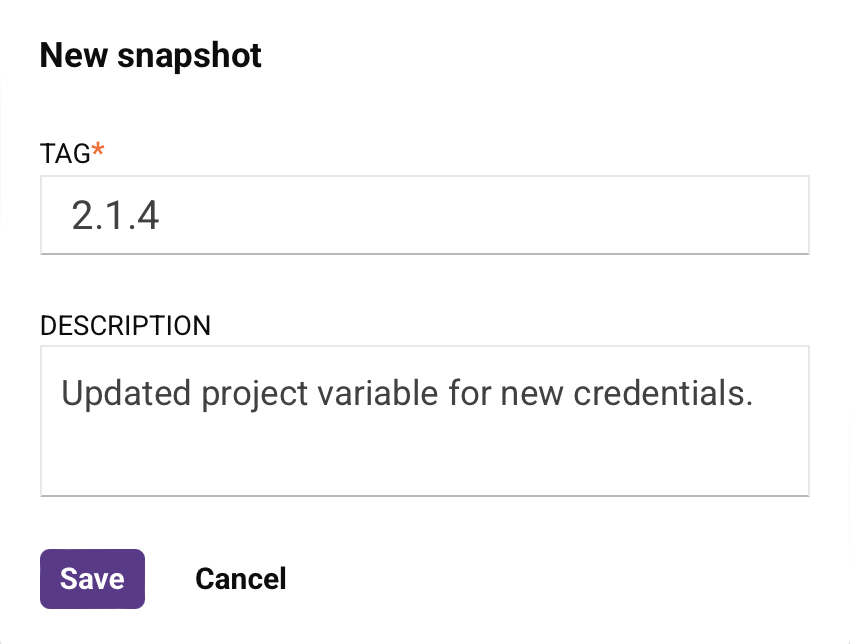
-
Tag: Enter a tag to label the snapshot. A unique tag is required.
-
Description: Enter a description for the snapshot.
Click Save to create the snapshot, or click Cancel to close the dialog without saving.
Note
Snapshots are stored indefinitely.
Tag or comment on events or snapshots
Transfer, deploy, and restore events in the Project history tab and snapshots in the Snapshots tab can be tagged and commented on with user-provided information. Tags are recommended for versioning.
Tag requirements
Transfer events must be tagged from the project transfer screen before the project can be transferred.
To require tags or comments at deploy time, configure this setting during project creation and configuration. When enabled, you see a dialog that requests the required tag or comment when you deploy the project.
Add tags and comments
You can add tags and comments to transfer, deploy, and restore events in the Project history tab, or add tags and descriptions to snapshots in the Snapshots tab. Tags are useful for versioning and organizing your project history.
To add or edit a tag, hover over the event or snapshot and click the details icon to open the dialog:
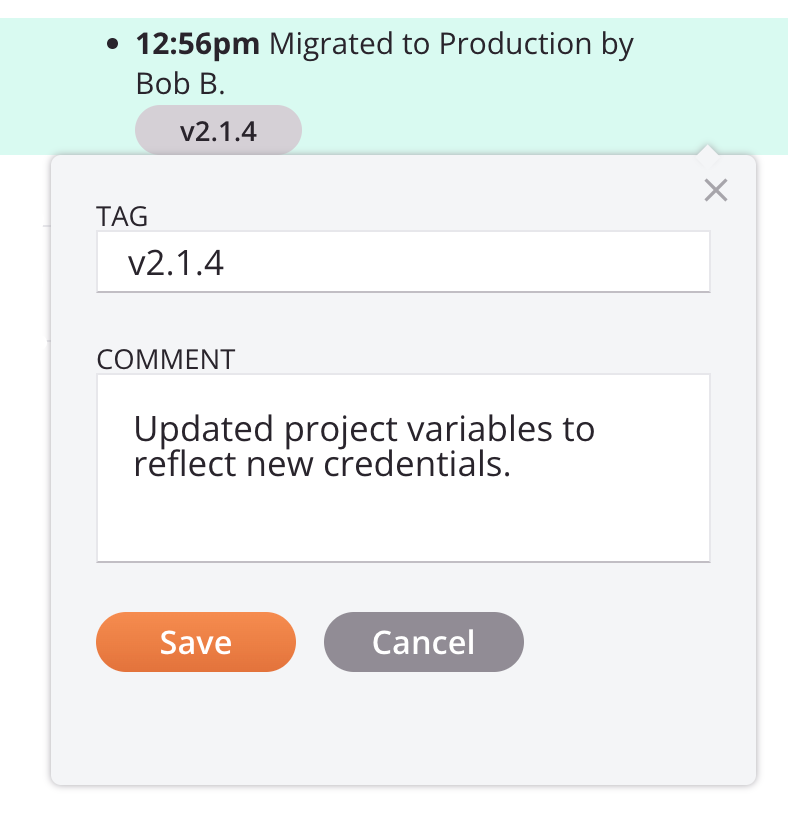
- Tag: Enter a tag to label the item. The tag is displayed as a label. A unique tag is recommended but not required.
- Comment (project history events) or Description (snapshots): Enter additional information to describe the event or snapshot.
Click Save to save your changes and close the dialog, or click Cancel to close the dialog without saving.
Tagged items are displayed in the drawer with the tag visible next to the item.

You can click the tag or the details icon to reopen the dialog and edit tags or comments that you added. If another user added a tag or comment, the details are displayed but are not editable.
Hovering over the tag shows a tooltip with the comment or description, if present.
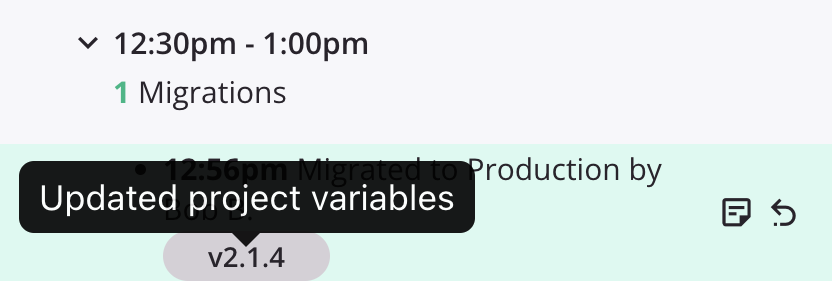
Restore a project
Project backups are automatically created when you transfer, deploy, or restore a project. Those project backups are available to restore from, as accessed through the project history drawer.
To restore a project to a snapshot or to an event that occurred within the last 180 days, hover on the event or snapshot and click the Restore this version icon.
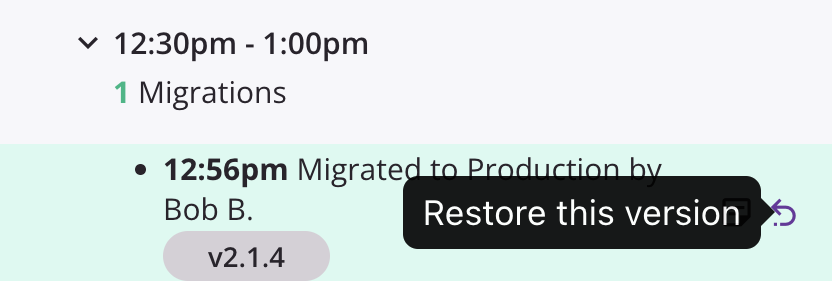
A confirmation message appears:
Dialog text
Restore this version?
Your current project will be restored to the version from date at time.
Click Restore to revert the project designer back to the previously deployed version and overwrite the current project.
Note that this action applies only to the project designer and does not affect the deployed version. Redeploy the project to deploy the restored state.
Alternatively, you can restore your project to the last deployed version by using the Restore last deployed version icon (described above).
Restore corrupted projects
The option to restore is disabled if the project is corrupted and cannot be opened. In this scenario, we recommend restoring the project to an earlier state before corruption occurred.
Multi-user collaboration during project restore
When multiple users are collaborating on the same project simultaneously and a user restores a project to a previous version, an informational dialog appears notifying users of the restoration. Closing this dialog updates their project to reflect the restored project state.
Note
This behavior is intentional to prevent unexpected changes to users' active work sessions without warning.